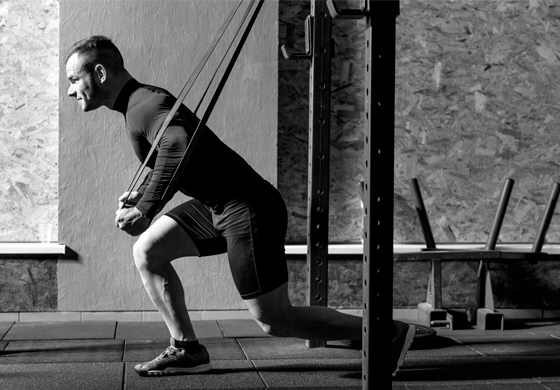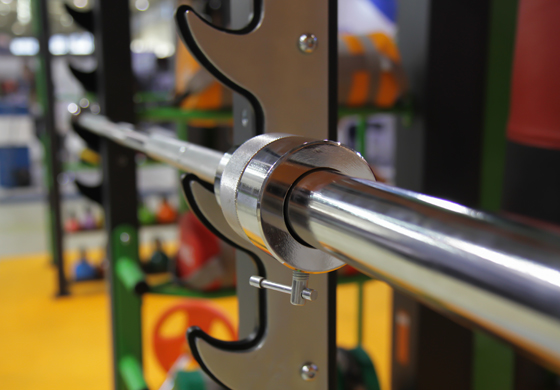Force – Velocity Profile: Accommodating Resistance

Box Squat vs. Free Squat: The Difference Coaches Forget
January 8, 2018Velocity based training (VBT) and Force-Velocity Profiling (FVP) are closely related. The FVP gives indication of strength, weakness, and balances of an individual’s physiological state based off of the force – velocity curve. There is a great deal of information regarding both areas but I have found very little on how to use accommodating resistance in synch with not only VBT, but FVP. In the summer of 2017 I was able to perform some informal experimenting on 10 Division 2 Football Athletes looking at how to balance their FVP by using VBT (tendo unit) and accommodating resistance (specific band tension ratios). Here are some interesting things that were discovered.
Stretch bands are an incredible way to develop power in the barbell lifts as they increase eccentric speed (overspeed eccentrics) to create a faster stretch of the musculo-tendinous units of the body during the lowering phase to allow for a greater storage and release of energy during the concentric phase of the lift. When bands, or chains even, are applied to a bar they actually mimic the human body’s changes in mechanical advantage through the range of motion of lift. In the squat, the body is in its strongest position standing straight up (where the moment arm matches the resistance arm), also where the highest band tension. As one lowers to the body of the squat, they reach their weakest position (where the resistance arm is acting at the farthest point away from the moment arm / axis of rotation) and the band tension mimics this, as the bands are weakest at the bottom. Lastly, the bands help to reduce bar deceleration. With light loads and no accommodating resistance, one cannot truly accelerate through the movement because if they did, the bar would go flying and turn into ballistics. So, there is a short phase where the body actually slows itself down before the completion of the range of motion (unless you are dealing with barbell ballistics). The bands essentially make the lifter drive through a load completely as the bands will always hold the bar down. Increasing eccentric speed, mimicking of biomechanical advantages and reduction of bar deceleration are three benefits that one gets from training with bands.
 The information laid out above is very well-known as Louie Simmons preaches this constantly. What is not made as clear is that one must understand band weight – straight weight ratios if they want to see desired effects in special strength development. Dr. Bryan Mann speaks briefly outlines guidelines for band-straight ratios that develop specific strengths (chart at bottom). The greater the band contribution to lifts the higher the velocity will be at the same relative load compared to lower band contribution. Relative load is a term that I use to help describe Force vs. Velocity centered loads during Dynamic Effort (DE) lifts. I found (only in a small study with a small sample size) that specific Relative Loads of 1RM showed trends of certain speeds with both Force DE lifts (band to straight weight ratio of 25% / 75%) and Velocity DE lifts (band to straight weight ratio of 50%/ 50).
The information laid out above is very well-known as Louie Simmons preaches this constantly. What is not made as clear is that one must understand band weight – straight weight ratios if they want to see desired effects in special strength development. Dr. Bryan Mann speaks briefly outlines guidelines for band-straight ratios that develop specific strengths (chart at bottom). The greater the band contribution to lifts the higher the velocity will be at the same relative load compared to lower band contribution. Relative load is a term that I use to help describe Force vs. Velocity centered loads during Dynamic Effort (DE) lifts. I found (only in a small study with a small sample size) that specific Relative Loads of 1RM showed trends of certain speeds with both Force DE lifts (band to straight weight ratio of 25% / 75%) and Velocity DE lifts (band to straight weight ratio of 50%/ 50).
It is important to note that these ratios were not perfect. Band tension is difficult to measure exactly as it is dependent on the band tension and the length at which it is stretched. So, for each subject, on each session, I needed to calculate the Relative Load of 1RM, the % of band and straight weight, and which band would yield the closest range.
After all this information, I know you are still wondering how this relates to an athlete’s FVP. These determinations above were used to make a progression of DE sessions of relative loads at either a Force or Velocity ratio. Squats to a box at ¾ depth (touch and go), not a full-sit power lift style, were used to develop strength in the range of motion that the majority of explosive sporting movements yield. The following are basic guidelines to progress from imbalanced to balanced FVP, either Force or Velocity Deficient:
Velocity deficient needs to work at higher band tensions (at or above 50%) to help their body recognize extremely fast speeds. Using VBT with a relative load progression of 80-85-90-95-100% of max with a 50% / 50% split in band to straight weight on the bar, will see great improvements in bar speed and FVP just in 5 weeks. The strength quality trained will range from explosive strength to speed strength as seen by the velocities produced using a Tendo-Unit. Desired Velocity is 1.13 m/s to 0.9 m/s throughout the progression. The key is; maximal intent to move the bar as fast as possible on every single rep. Without this, there will be no transfer.
Force deficient athletes need to get stronger as they usually lack absolute strength. The contribution to improved FVP is more unknown regarding DE ability. The key is, the athletes in the study all improved on their absolute strength. These athletes need to develop high forces as well as learn to produce them at higher speeds to continue to produce power. That is why there is a lower band contribution and the special strength trained is Strength Speed (between 0.89 and 0.7m/s) Using VBT with a relative load progression of 65-70-75-80-85% of max with a 25% / 75% split in band to straight weight on the bar, one will be able to see benefits in strength speed.
*Extra notes: Again, the key with these types of athletes is really absolute strength. One day in a week, these types of athletes should perform core lifts (box squat, squat, and deadlift variations) using VBT and the desired speed is at 0.5-0.69 to see benefits in absolute strength. Volume should be kept to approx. 15 efforts.
**Velocity Deficient athletes need to continue to work on higher intensities of strength as well. On the “heavier” days, for a 5 week protocol prescribing high intensity work to be between 0.7 m/s and 0.75 m/s will yield benefits in speed strength and can translate to increased absolute strength as well.
Strength |
% of 1RM (Relative load) |
Velocity |
Explosive Strength *
|
20-40%
|
1.2-1.5 m/s
|
Speed Strength *
|
40.1% – 60%
|
1.13 – 0.9 m/s
|
Strength Speed **
|
61.1% – 75%
|
0.82 – 0.67 m/s
|
Absolute Strength **
|
80% – 100%
|
0.89 – 0.56 m/s
|
* Velocity Deficient Training Zones
** Force Deficient Training Zones
- Information derived VBT and Dr. Bryan Mann as well as Strong By Science Max Schmarzo and Matt Van Dyke



